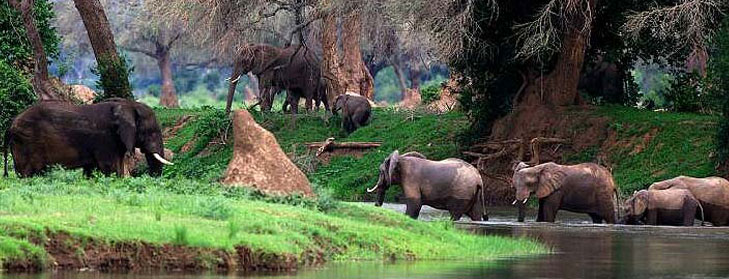Jackal Berry/African ebony - Diospyros mespiliformis
 The Jackal Berry is one of the largest and most majestic species to be found in the Okavango Delta. Its dark, sombre look is attributable to its dense, dark-green crown and the dark uniform sectioned stem. The stem typically forks into two main branches. The characteristically undulating leaves are dark green in summer, but turn bright yellow in autumn, making the tree very conspicuous. Animals, birds and humans relish the sweet yellow-green berry it bears. There are two explanations for the name 'Jackal berry', the one being that the seeds of the fruit have been found in jackal droppings and the other that the berries are not very visible, and thus are elusive as a jackal. The tree can reach up to 25m in height with a stem diameter of 1,5 metres, but when unlimited water is availiable, it can grow even taller.
The Jackal Berry is one of the largest and most majestic species to be found in the Okavango Delta. Its dark, sombre look is attributable to its dense, dark-green crown and the dark uniform sectioned stem. The stem typically forks into two main branches. The characteristically undulating leaves are dark green in summer, but turn bright yellow in autumn, making the tree very conspicuous. Animals, birds and humans relish the sweet yellow-green berry it bears. There are two explanations for the name 'Jackal berry', the one being that the seeds of the fruit have been found in jackal droppings and the other that the berries are not very visible, and thus are elusive as a jackal. The tree can reach up to 25m in height with a stem diameter of 1,5 metres, but when unlimited water is availiable, it can grow even taller.
The Jackal berry is a common component of island communities and is mostly associated with permanent watercourses but it grows on all soil types, especially on termitaria. It is more common at Third Bridge and Xakanaxa than at Khwai.
The fruits provide nutrition for birds, humans and animals alike, including carnivores such as jackal. The African civet, which is mainly herbivorous, is another frequent visitor to this tree at night. The high sugar content of the fruit makes it a favourite with local people for brewing beer and when distilled, a 'brandy' of impressive potency results. The pulp can be eaten raw or dried as a flour. The berry is among the tastiest found in the area. The dense foliage provides excellent protection for birds - Grey Louries, Meyer's Parrots and large numbers of Green Pigeons are always present, as are squirrels, monkeys and baboons. The Basawra (Bushmen) often use the fruit as bait to trap small animals and birds.







